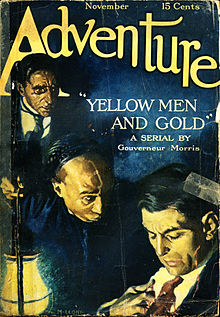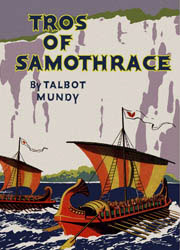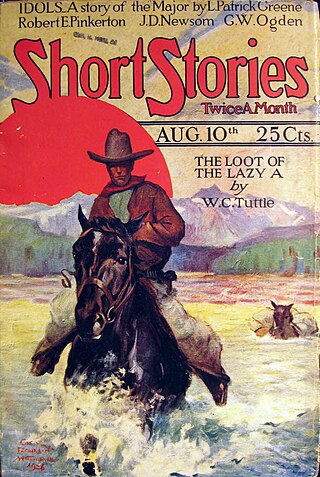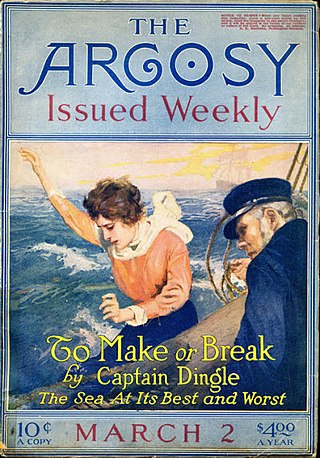The Hoffman era
In its first decade, Adventure carried fiction from such notable writers as Rider Haggard, Rafael Sabatini, Gouverneur Morris, Baroness Orczy, Damon Runyon and William Hope Hodgson. [7] Subsequently, the magazine cultivated its own group of authors (who Hoffman dubbed his "Writers' Brigade"). Each member of the "Writer's Brigade" had his or her own particular fictional bailiwicks. These included Talbot Mundy (colonial India and ancient Rome), T.S. Stribling (detective stories), Arthur O. Friel (South America), brothers Patrick and Terence Casey ("hobo" stories), J. Allan Dunn (the South Seas), Harold Lamb (medieval Europe and Asia), Hapsburg Liebe (Westerns), Gordon Young (South Pacific stories and urban thrillers), [8] Arthur D. Howden Smith (Viking era and US history), H. Bedford-Jones (historical warfare), W.C. Tuttle (humorous Westerns), Gordon MacCreagh (Burma and East Africa), [9] Henry S. Whitehead (the Virgin Islands), Hugh Pendexter (US history), Robert J. Pearsall (China), and L. Patrick Greene (Southern Africa). [10]
In 1912, Hoffman and his assistant, the novelist Sinclair Lewis created a popular identity card with a serial number for readers. If the bearer were killed, someone finding the card would notify the magazine who would in turn notify the next of kin of the hapless adventurer. The popularity of the card amongst travelers led to the formation of the Adventurers' Club of New York. [3] The original New York club led to similar clubs in Chicago (1913), Los Angeles (1921), Copenhagen (1937) and Honolulu (1955). [11]
In 1915 the publishers attempted to reach women readers with a new title (Stories of Life, Love, and Adventure), but it went back to its male readership and original title in 1917. [12]
Hoffman also was secretary of an organization named the "Legion" that had Theodore Roosevelt Jr. as one of its vice presidents. Membership cards of the organization included member's skills and specialties that were forwarded to the War Department when the United States entered World War I, the information being eventually used to create two regiments of aviation mechanics. [3] Hoffman's group would later provide a model for the organization of the American Legion after the war. [13]
Adventure's letters page, "The Camp-Fire" featured Hoffman's editorials, background by the authors to their stories and discussions by the readers. At Hoffman's suggestion, a number of Camp-Fire Stations – locations where other readers of Adventure could meet up – were established. Robert Kenneth Jones notes that Adventure readers "often wrote in to report on meeting new friends through these stations." By 1924, there were Camp-Fire Stations established across the US and in several other countries, including Britain, Australia, Egypt and Cuba. Adventure also offered Camp-Fire buttons which readers wore. [14] Adventure featured several other notable columns, including:
Hoffman encouraged the details of his writers' fiction to be as factually accurate as possible-mistakes would frequently be pointed out and criticized by the magazine's readers. [16]
In addition, Adventure under Hoffman also showcased the work of several famous artists, including Rockwell Kent, John R. Neill (who illustrated several Harold Lamb stories), Charles Livingston Bull, H.C. Murphy and Edgar Franklin Wittmack. [17] Under Hoffman's editorship, Adventure's circulation reached a height of 300,000 copies per month. [4] By 1924, Adventure was regarded, in the words of Richard Bleiler, as "without question the most important 'pulp' magazine in the world." [5]
In 1926, the Butterick company decided to print Adventure on slick paper instead of wood-pulp paper. They also changed the magazine's covers to a text listing of contents. Both of these decisions were done in the hope of winning over readers of the "slick" magazines, such as The Atlantic and Harper's Magazine . [5] However, the magazine's style of fiction did not change, and the new Adventure failed to win over "slick" magazine readers, instead suffering a twenty percent fall in circulation. Hoffman, unhappy with the change of format, left the magazine in 1927. [5]
Later years
After Hoffman's departure, his successors usually followed the template for the magazine that he had set down. In 1934, Adventure was bought by Popular Publications. [5] Throughout the 1930s, Adventure included fiction by Erle Stanley Gardner, Donald Barr Chidsey, [17] Raymond S. Spears, Major Malcolm Wheeler-Nicholson, Luke Short, and Major George Fielding Eliot. Adventure continued to publish factual pieces by noted figures, including future film producer Val Lewton [18] and Venezuelan military writer Rafael de Nogales. [19] In November 1935, editor Howard Bloomfield assembled a special issue to celebrate Adventure's 25th anniversary. This issue featured reminiscences of the magazine's history by Arthur Sullivant Hoffman. [20] The issue also featured reprints of popular Adventure stories by Mundy, Friel, Tuttle and Georges Surdez. [20] The anniversary of the magazine was covered in the media, with Time magazine praising Adventure as being "the No. 1 'pulp'" [4] and Newsweek lauding Adventure as "Dean of the pulps". [21]
During the 1940s, the magazine carried numerous fiction and articles concerned with the ongoing Second World War; writers who contributed to Adventure in this period included E. Hoffmann Price, De Witt Newbury, [22] Jim Kjelgaard and Fredric Brown. Artists on the publication during the 1930s and 1940s included Walter M. Baumhofer, Hubert Rogers, Rafael De Soto, Lawrence Sterne Stevens and Norman Saunders. [17] The magazine's main editor in the 1940s was Kenneth S. White, the son of the magazine's first editor Trumbull White. [5] In April 1953, the pulp changed its format to that of a men's adventure magazine that lasted until the magazine folded in 1971. [12] This final incarnation of Adventure tends not to be highly regarded among magazine historians, with Robert Weinberg referring to it as "a rather mundane slick magazine" [23] and Richard Bleiler stating that by 1960 Adventure had become "a dying embarrassment, printing grainy black and white photos of semi-nude women". [5] Nevertheless, this version of Adventure did sometimes publish fiction by noted authors, including Arthur C. Clarke ("Armaments Race", in the April 1954 issue) and Norman Mailer ("The Paper House" in the December 1958 issue). [5] The final four issues restored the fiction emphasis in a digest format, but that incarnation also folded.











